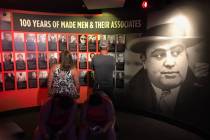’42’ movie stirs Jackie Robinson memories
If many of you are like me and my wife, you saw the movie “42” sometime in recent weeks at the Suncoast and walked out of the theater raving about how much you had enjoyed the last two hours.
Many in the theater lobby talked about how they remembered April 15, 1947, the day Jackie Robinson broke the color barrier in organized baseball as the new first baseman for the Brooklyn Dodgers. And many remembered how he subsequently experienced some of the most despicable treatment any human being could endure.
Others talked about seeing Robinson play at Ebbets Field, or once meeting him, or still owning a baseball signed by the first black man to play major-league baseball.
Me? Well, I recall the days when I wrote about sports and covered baseball –– in particular the Brooklyn Dodgers –– for the Star-Ledger in Newark, N.J. Those days began more than seven years after Robinson made his debut. Things had settled down considerably among the Jim Crow crowd by then, and Robinson had long since become just another player in the Dodgers’ lineup –– albeit a very exciting one.
So what does all this have to do with Summerlin? Nothing, other than the fact that I live in Summerlin, and the Suncoast sits near Summerlin. And I’m writing this column because I feel privileged to have known Robinson and to have written extensively about him and his accomplishments.
Just as Branch Rickey, then part-owner of the Dodgers, had prophesized, once Robinson paved the way, “There will be many more to follow him.” And there were, such as Don Newcombe, Roy Campanella and Jim Gilliam.
Ebbets Field was a “field of dreams” for some, including me. In 1954, I was 21 and just out of college. I still recall the first time I heard that creaking sound of the tiny elevator, which took me from ground level to the press box. And as I looked out at the expanse of a ballpark that was often characterized as a “band box” because of its size –– in the mode of Chicago’s Wrigley Field and Boston’s Fenway Park –– I truly thought I had died and gone to heaven.
The Dodgers’ lineup that day included Robinson at third base, Gilliam at second, Campanella catching and Newcombe –– a tower of a man –– pitching. Seven years after Robinson endured unmitigated insults due to the color of his skin –– and just as the prophetic Rickey had predicted –– there were four black men in the Dodgers’ starting lineup. And one more, pitcher Joe Black, sat in the bullpen.
By then, the game had become so integrated that almost every major-league team was fielding black players.
As a point of interest, Robinson was not necessarily the first consideration of the Dodgers’ high command for the difficult task that lay ahead. Campanella and Newcombe were in the mix as well.
In his book “The Era,” Roger Kahn, who also wrote “The Boys of Summer” –– the classic anthology relating to the Dodgers of the early 1950s –– indicated that Newcombe was being seriously considered for the role. In fact Buzzie Bavasi, who served as general manager for almost a generation, reportedly said that at one time Newcombe was the guy they wanted.
But Newcombe was only 21 the day Robinson made his debut. Robinson was 28. The difference was more than just maturity and the ability to withstand the pressure. Robinson was an everyday player. As a pitcher, Newcombe took the field every fourth or fifth day.
I have a vivid memory of Newcombe and an incident in 1955 when he jumped the Dodgers’ ball club due to a disagreement. Nobody was able to find him. It was a big story in the New York area at the time. “Newk,” as he is still called today, grew up in Elizabeth, N.J. His parents lived in Linden, the city next to Elizabeth. I found Newk at his parents’ home. It turned into a big story for me.
But nothing matched covering the Robinson-era Dodgers, right up to his retirement from baseball in 1956.
Herb Jaffe was an op-ed columnist and investigative reporter for most of his 39 years at the Star-Ledger of Newark, N.J. His newest novel, “All For Nothing,” is now available. Contact him at hjaffe@cox.net.












